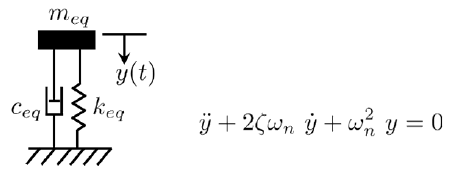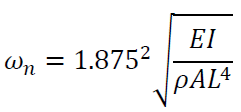MEMS 431 (FL11) Lab 4
Estimating Material Properties of a Beam
Objective
To design an experiment to measure the material properties of a bar of unknown material using vibration measurements.
Background
The need often arises in engineering to estimate the material properties of an oject. The analysis of the dynamic response of the system can be an effective method of characterizing the material. In this experiment, the Young's modulus (modulus of elasticity), density, and damping ratio of an unknown material are to be determined using vibration analysis. The material specimens are long, slender beams of rectangular cross-section. The dynamic response of a beam depends on the boundary conditions at each end (fixed, pinned, free, rolling, etc.). One common configuration is the cantilever beam, in which one end is fixed in translation and rotation, while the other end is free, as shown in Fig. 1.

Figure 1. Free vibration of a cantilevered beam.
The equation of motion for the beam is a partial differential equation (fourth order in space and second order in time). The full beam equation solution will be discussed toward the end of the semester. A beam is a continuous system, with an infinite number of natural frequencies. However, the response is often dominated by the lowest natural frequency. Thus, it is possible to create a single DOF mathematical model with an equivalent mass, spring stiffness, and damping such that the natural frequency of the model matches the lowest natural frequency of the beam. The simplified mathematical model is shown in Fig. 2.

Figure 2. Simplified mathematical model.
For a cantilever beam, the undamped natural frequency is given by the following equation:

Reading
Review textbook sections on analysis of damped single DOF systems.
Investigation
Each lab group is assigned a material specimen. Please record the number written on the side of the specimen and include this in the report. Using the available lab resources (scale, accelerometer, data acquisition system, clamps, etc.), the lab group should design an experimental protocol to determine the following material properties of the sample: density, modulus of elasticity, and damping ratio. These properties are to be determined from the experiment.
Report
The format for the lab report is an extended abstract. The following topics should be addressed:
a. PROCEDURE Sketch the setup and describe the steps of the experimental protocol used for the investigation.
b. RESULTS Present the estimated density, modulus of elasticity, and damping ratio. Given the material properties found in the experiment, what is the material of the beam?
c. DISCUSSION How do the experimental material properties compare to published values for the material? Discuss the possible sources of error in the experiment.